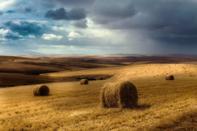Determining Saleability
Standing beneath the clattering tin roof with the rain thrashing down and churning the dirt road outside to an ochre soup, farmer Jan Scheepers reaches down to pick up a fistful of beans so he can inspect his produce. He opens his fist to reveal a mound of lightly speckled beans in his palm, the colour of cappuccino froth.

They click click clack against one another as he prods at them with a finger, sweeping them into a single layer on his flattened hand, so he can check for faint colour variations, which determine their saleability. ‘When beans are in hot and humid weather they tend to turn darker in colour, like this.’ His fingers single out a bean, its sleek skin tinted to a shade slightly darker than milky coffee.
‘This is weather damage,’ he says as he prods at the bean, ‘and that’s why we can compete with the Chinese. Because their beans have to go over the equator in wet or humid conditions, they turn brown. ‘And if beans are kept longer than a year, they turn this brownish colour. The buyers like the lighter ones.
So if you put these coloured beans next to the lighter beans on the shelf, they’ll always prefer the lighter colour, although there’s nothing wrong with these.’ The beans clatter to the floor as he drops his hand. Back in his office, he continues with a reassuring pragmatism, his blonde accountant wife, Amelia (33), to his left. ‘I’m actually taking quite a knock at the moment on the beans.’
As Fickle as the Weather
Farmers like Jan Scheepers understand the swing-and-roundabout nature of the business. In fact, even though the wheat also got hammered by the rain, because he was selling it into a globalised market that is as fickle and capricious as the weather, he managed to break about even in the end.
When the first harvest of wheat came in at the end of December 2010 and early in January, it was before the rains started. He sold his best grade for a good price, about R2 600 per tonne. ‘Then the rain started. There was a severe crop loss in Australia, they had the same rainfall patterns. They couldn’t harvest, and they had bad grades as well.
The Argentines had a drought, which also goes along with this La Niña we’re having, and they closed their exports.’ Russian wheat stocks, meanwhile, were buckling under a drought and devastating fires that knocked out huge areas under wheat production. They also closed their exports in a bid to shore up domestic wheat supplies.
By this time, the rest of Jan’s wheat was so sodden that, come harvest, it began germinating in the fields. ‘We had a very bad grade. We had feed grade for our wheat.’
Some You Lose, Some You Win
But just as he was lamenting having to bring in tonnes and tonnes of wheat that was only good for feeding livestock, the price began to climb because of the global shortages. So while he got R2 600-odd per tonne for his best grades, he got much more than he should have for the bad stuff. ‘My rotten wheat I sold for R2 550.
It should have been R600 or R700 a tonne lower, but because of the global crash in the wheat market, the crash in production, the market jumped up and in January I sold the rotten wheat for about the same price I sold the good wheat. ‘So I didn’t get the benefit of the price rise on my good wheat, but it made my average the same.
So, on the wheat I didn’t take that great a knock. That was quite nice. ‘That’s how it works in the global markets,’ he says. ‘Some you lose, some you win.’
By Leonie Joubert